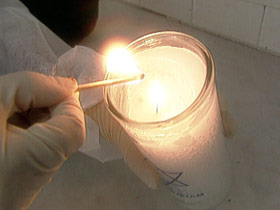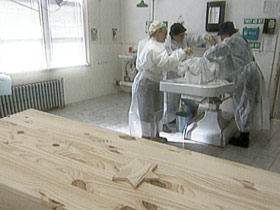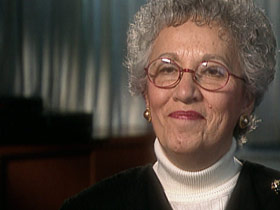In This Episode << SLIDE LEFT TO SEE ADDITIONAL SEGMENTS
Jewish Burial Practices
BOB ABERNETHY, anchor: We have a moving “Belief and Practice” segment this week on the Jewish tradition of tahara, the washing and purifying of a dead body, which is considered one of the greatest of all good deeds — mitzvot. Those who perform taharas are volunteer members of the burial society, chevra kadisha. Women attend to deceased women, men to men.
In Jewish practice, if possible, a body is buried within 24 hours. There is no embalming. Our producer Susan Goldstein found three women in Westchester County, New York — Rochel Berman, Nancy Klein, and Mina Crasson — who have been doing taharas for more than 20 years. They agreed to describe their work and demonstrate it on a mannequin, in keeping with the tradition of respecting the dead.

ROCHEL BERMAN (Chevra Kadisha, Jewish Burial Society of Westchester, New York): No matter whatever is going on in my life, before I walk into the tahara room, no matter how troubled or obsessed I might be about something, it totally disappears during the time of the tahara.
It is the most profound connection with my Judaism. Both task-oriented and spiritual at the same time, and so intensive that it’s almost a lesson for how to do other commandments.
I think it’s considered the greatest mitzvah because the person that you are serving, the deceased, can’t say, “Thank you.”
The purpose of the tahara is to provide comfort for the soul and care for the body. We talk very little, except about the tasks at hand. When we are working on the deceased, we never pass anything over the body. We always walk around as a sign of respect for the dead. I have a distinct sense that the soul is hovering and is in transition as we do this, and that makes us that much more careful with the body.
NANCY KLEIN (Chevra Kadisha, Jewish Burial Society of Westchester, New York, reading prayer): May it be your will, Lord our God and God of our Fathers, to bring a circle of angels of mercy before the deceased, for she is your servant daughter.

Ms. BERMAN: It’s definitely changed me. For one thing, it’s put my own mortality in a much sharper focus. I don’t think I have a fear of death, and I could kind of imagine what that would be like. I have thought about my own tahara. And I also find it so enormously uplifting and rewarding that if I would get a call to do it, why wouldn’t I do it? It makes me feel so good about myself; it gives a lift to the rest of the day.
I always like to look at a tahara — it is almost analogous to a three-act play. There are three distinct parts: there is cleansing, there’s purification, and there’s dressing. In the cleansing phase of the tahara, we remove all the bandages and anything extraneous on the body.
Ms. KLEIN (reading): And I will pour upon you pure water.
Ms. BERMAN: The purification is a cascade of 24 quarts of water that are poured by the entire team in a continuous flow. And it is analogous to a mikvah, which is a purification that women go through following their menstrual cycle.
And it’s as if we were washing away all the suffering of their last periods of their lives, and it’s as if it is like a veil that you leave behind.
MINA CRASSON, Ms. KLEIN, and Ms. BERMAN (reading prayer in unison): Tahara he, tahara he, tahara he. She is pure. She is pure. She is pure.
Ms. BERMAN: And then the body is dried, and the final stage is dressing in the shrouds.

The shrouds are fashioned after the garments that the high priest wore in the temple on Yom Kippur, and they’re white, usually made of linen, hand-sewn with no knots so that they will disintegrate easily. They also have no hems to signify the impermanence, and no pockets, so that you take no worldly goods with you. And everybody, rich or poor, young or old, religious or nonreligious, are all buried in the same garments.
And then the body finally is placed in the casket and wrapped in a large sheet, which creates almost a cocoonlike image. And there is a sense of protectiveness as the person enters the world to come.
We sprinkle earth from Israel at the bottom of the casket before we place the body in there, and after the deceased is completely shrouded, we place it on the eyes and on the heart, and that is our connection with our homeland.
At the end of the tahara, before we close the lid, the team gathers around the casket to ask forgiveness of the soul for any errors of omission or commission, and assure the soul that we have done everything within our power to do this correctly, in accordance with our customs.
Ms. KLEIN (reading prayer): Dina, daughter of Jacob, we ask forgiveness from you if we did not treat you respectfully, but we did as is our custom. May you be a messenger for all of Israel. Go in peace, rest in peace, and arise in your turn at the end of days.
Ms. BERMAN: We address the deceased by name, and that makes it very specific and personalized. And I usually wish her well.

